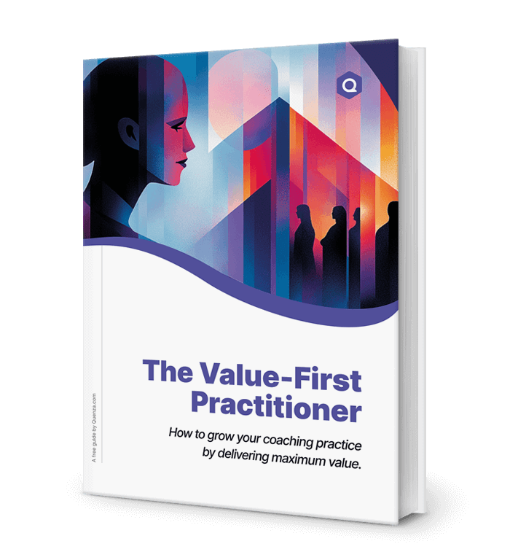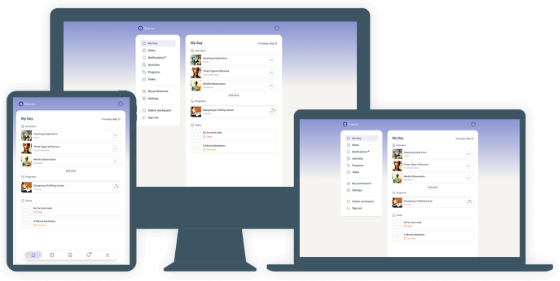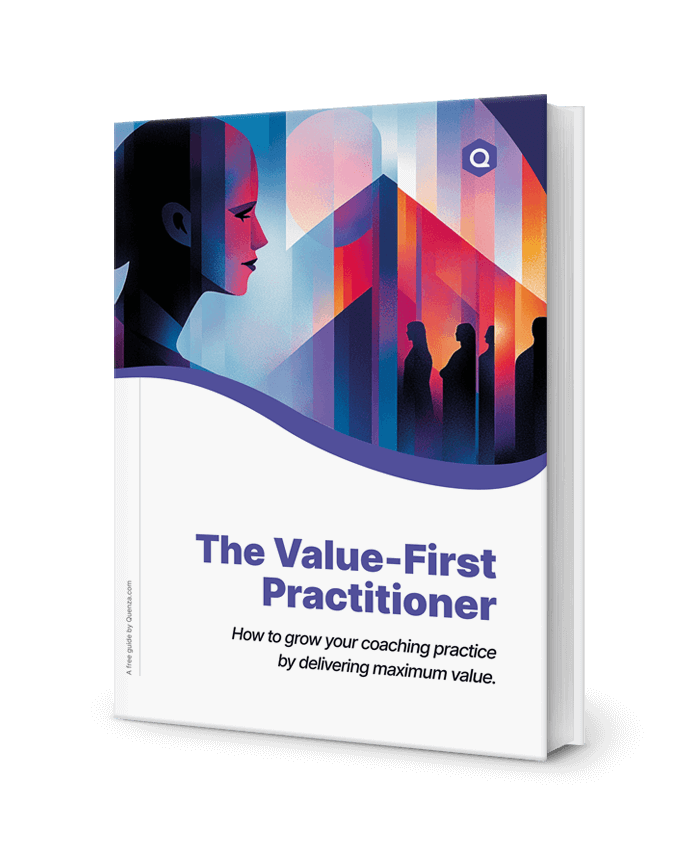The GROW coaching model is a popular action-oriented framework for helping clients achieve their goals.
This article will show you how to implement the model effectively in your work, including example GROW model questions, real-life scenarios, and a PDF worksheet template to use or adapt for your clients.
What Is the GROW Model for Coaching?
GROW is an acronym for Goals, Reality, Options, and Will (or Way Forward).
Developed in 1992 by Sir John Whitmore, Graham Alexander, and Alan Fine in Whitman’s book Coaching For Performance, the goal of this four-step coaching model is to enable structured coaching conversations while giving a client deeper insight into their context and challenges.[1]
The framework covers the four essential elements of an effective coaching journey, with focused questions for each stage in the process as shown below.[2]

The GROW coaching model steps are as follows:[3]
Goal: A client’s ambitions or aspirations
Reality: Their current challenges and/or context
Options: Resources, strengths, and/or possibilities for achieving their goals
Will: Actions they might take and accountability.
Implementing the GROW model helps you guide clients through the process of setting clear and achievable goals, exploring their current reality, identifying possibilities for moving forward, and committing to specific actions.
To implement the model effectively, the first step is for coaches to help their clients set intrinsically motivating Goals—goals that are both inspiring and challenging.
The duration and specific focus of the subsequent Reality and Options stages can be flexibly adapted to the client’s circumstances. During the final step Will, the focus is on establishing what a client is prepared to do in order to achieve their goal and a potential structure for implementing those actions.
Both the Goals and Will stages can be revisited as required.
How To Apply It: 20 Example Questions
As with all coaching, a professional’s role is to enable clients to find their own solutions. Actioning Whitmore’s framework is about asking the right questions for each stage in their journey.
Here are some GROW model questions to tailor to your client’s needs, aspirations, and coaching context:
Goal:
- What is the specific outcome or goal that you want to accomplish?
- How will you know when you have achieved it?
- Is this goal realistically achievable?
- How will accomplishing this goal change your life for the better?
- Imagine you have accomplished your goal several months from now. What does success look, sound, or feel like? What is different?
Reality:
- What is your current context or status in relation to this goal?
- What roadblocks or challenges are you facing right now?
- On a scale of 1–10, where your ideal situation is 10, what number are you at now?
- What steps have you taken so far to achieve this goal, successfully or unsuccessfully?
- How does this goal align with the larger context of your life or career?
Options
- What are some potential strategies or solutions for achieving your goal?
- What are the advantages and disadvantages of each?
- Have you researched any best practices or successful examples related to this goal?
- Where could you find the information or support that you need in order to succeed?
- What internal, social, or external resources are available to you to help you accomplish this goal?
Will:
- What specific steps will you take to achieve this goal?
- What are your sub-goals, milestones, or deadlines?
- How will you track your progress?
- On a scale of 1–10, where 10 is fully committed, how committed are you to taking that action?
- What roadblocks or challenges do you expect to encounter, and how do you plan to address them?
You can find more useful questions here: 43 Powerful Life Coaching Questions To Ask Your Clients
3 Practical GROW Coaching Model Scenarios
The GROW model itself is highly flexible. With the right attention to a client’s specific coaching circumstances, it can be used to facilitate self-discovery, clarity, and improved performance in a huge range of developmental contexts.[4]
Let’s look at some practical GROW model example scenarios in more depth.
1. Leadership/Organizational Coaching
Using the GROW framework is a great way to structure coaching conversations, foster intrinsic motivation, and establish a positive coaching culture within organizations.
An example coaching sequence in this context might flow as follows:
Goal: A manager wants to improve their customer satisfaction ratings by 20% over the next three months.
Reality: They discuss their current customer lifecycle and relationship-building strategies with their coach. They identify that their key challenges are empathizing with customer pain points and responding efficiently to inquiries.
Options: The coach and manager brainstorm various strategies for improving the customer journey and streamlining the inquiry process, such as implementing feedback forms, focus groups, and customer relationship software. They also explore different efficiency tactics, such as automating repetitive tasks and improving the manager’s time management.
Will: The manager and coach agree on an action plan and “next steps” that include drafting a feedback form, hosting three focus groups a week, and finding a suitable CRM for the sales journey. They set a specific customer satisfaction rating target for the three-month mark and plan fortnightly check-ins to track progress and tackle any obstacles that crop up.
2. Group Coaching
Another advantage of the GROW model is that it can be used to keep coaching groups focused and on track. It also encourages collective brainstorming and discussion, fostering a collaborative environment and allowing for a wider range of potential solutions for achieving the group’s goals.
Goal: Each group member describes their specific, measurable, and time-bound goal for the session.
Reality: Each member then shares their current reality with respect to their goal, describing any roadblocks or challenges they are struggling with and any progress they have made thus far.
Options: The group collectively brainstorms potential strategies or solutions for overcoming the obstacles and accomplishing the goal. This is a great opportunity for outside-the-box thinking and expanding on one another’s input to unlock more creative potential options.
Will: Lastly, each member commits to specific actions they will take to progress towards their goal. A timeline may be created that uses sub-goals, milestones, and deadlines to track client progress.
The GROW model encourages collective brainstorming and discussion in group coaching contexts. This can foster a collaborative environment, allowing for a wider range of potential solutions for achieving the group’s goals.
3. Teaching/Learning
Educators can also use the GROW coaching model to help students set clear goals for improving their performance and provide any necessary support and guidance as they implement their action plans.
Here’s an example of how it can be used to identify a student’s needs, develop options, establish an action plan, and monitor their progress.
Goal: The teacher and student collaborate to identify the student’s specific learning goal, for example “to improve their understanding of photosynthesis.”
Reality: Both parties assess the student’s current situation together. The teacher assesses the student’s existing understanding of photosynthesis and the student describes any challenges they have been facing. The teacher helps the student to identify any gaps in their understanding that might be preventing them from better understanding the concept.
Options: The teacher and student collaborate to come up with potential solutions. The teacher suggests various strategies for learning more about photosynthesis, such as using YouTube videos, practicing mock exams, or working with an online tutor. The student weighs up the pros and cons of each and decides which option they want to pursue.
Will: The teacher and student formulate an action plan for which the student sets specific, measurable, and achievable goals for improving their understanding. They also identify the resources required to accomplish these goals and overcome any potential challenges, with the teacher providing the student with support, guidance, and learning resources.
Will: Both parties agree on a time frame for achieving the goal and how the student’s progress will be tracked or adjusted. The student commits to taking specific actions to increase their understanding of photosynthesis and the two plan accountability check-ins to help the student stay on track.
See also: How To Create An Online Course With The Quenza Platform
Example PDF Worksheet (& Answers)
Ready to help your clients by applying the GROW framework in practice?
Download the comprehensive, 6-page PDF GROW coaching model worksheet that we created for you, with 23 coaching questions that will help your clients identify, plan, and commit to their next actions.
This exercise will take your clients through each step of the GROW framework, with writing prompts for each of the Goal, Reality, Options, and Will stages in turn. A few example prompts include:
- What life domain would you like to work on? (Goal)
- With this domain in mind, what specific goals do you want to achieve, and in what time frame? (Goal)
- Describe what has been happening in your current situation. (Reality)
- What have you tried so far to achieve your goal, and what were the results? (Reality)
- If you were to pursue your goal, how might you go about it? (Options)
- What else could you do to achieve your goal? (Options)
- What is the first step you will take, and when will you take it? (Will)
- What obstacles might get in your way? (Will)
 Creating Your Own GROW Model Worksheet
Creating Your Own GROW Model Worksheet
Looking for something slightly different to suit your client’s context?
If this worksheet doesn’t quite match your client’s needs, why not create your own?
(Feel free to use the GROW model questions we’ve provided!)
Watch this 5-minute video for a step-by-step guide to designing and sharing an interactive, personalized GROW model exercise using simple drag and drop tools:
The Role of Active Listening in the GROW Model
Active listening is a critical skill for any coach employing the GROW model. It involves fully concentrating, understanding, responding, and then remembering what the client says. In the context of the GROW model, active listening helps coaches understand the client’s current reality and the nuances of their goals and challenges.
By practicing active listening, coaches can pick up on subtle cues and emotions that might indicate underlying issues or unspoken concerns. This deeper understanding allows for more tailored and effective coaching interventions. For instance, when a client discusses their current reality, an active listener might notice hesitations or contradictions that signal areas needing further exploration.
Moreover, active listening fosters trust and rapport, essential components for a successful coaching relationship. Clients who feel heard and understood are more likely to open up, share honestly, and engage fully in the coaching process. Thus, integrating active listening into each stage of the GROW model not only enhances the accuracy of the information gathered but also strengthens the coach-client relationship, ultimately leading to more meaningful and sustainable outcomes.
Integrating Feedback Mechanisms in GROW Coaching
Feedback is a powerful tool in coaching, and its integration within the GROW model can significantly enhance the coaching process. Regular, constructive feedback helps clients understand their progress, recognize areas for improvement, and stay motivated.
During the “Will” phase of the GROW model, where action plans are created, feedback mechanisms can be established to monitor progress and adjust strategies as needed. This could include setting up regular check-ins, using self-assessment tools, or leveraging feedback from peers or stakeholders. The key to effective feedback is ensuring it is specific, actionable, and delivered in a supportive manner.
Coaches can use feedback to highlight successes, reinforce positive behaviors, and provide guidance on overcoming obstacles. By incorporating feedback into the GROW model, coaches can create a dynamic and responsive coaching environment that adapts to the client’s evolving needs and circumstances.
This continuous loop of feedback and adjustment not only keeps clients on track but also empowers them to take ownership of their development and make informed decisions, thereby enhancing the overall effectiveness of the coaching engagement.
Final Thoughts
If your mission is to support your clients with a clear and structured approach to achieving their goals, the GROW model has a lot to offer. Hopefully, you’ve found enough advice and inspiration in here to apply this versatile framework to your next coaching journey!
If you’ve found this article valuable, we have even more resources to help you up your professional game. Take a look at our free 30-page coaching guide for actionable, up-to-the-minute tips that will help you scale your coaching practice today.
Frequently Asked Questions
The GROW coaching model has been widely used and studied, showing it to be an effective coaching tool in many contexts. It provides a structured approach to coaching, allowing coaches to guide clients through the coaching process and focus on specific, achievable goals. By providing a clear framework, the GROW model can help coaches and clients to work together more effectively and efficiently, leading to positive outcomes.
Critics argue that the GROW coaching model is too rigid and formulaic, limiting coaches’ ability to adapt to each client’s unique needs and contexts. It may also neglect important aspects of the coaching relationship, such as building trust and rapport. Focusing on achieving specific outcomes may also create pressure or anxiety for some clients.
The strengths of the GROW model include its simplicity, flexibility, focus on specific goals, clear structure, and measurable outcomes. It helps coaches and clients work together effectively and achieve positive outcomes.
A GROW Model Template is a tool used by coaches to guide their coaching sessions and ensure they follow the GROW Coaching Model structure. It typically includes four key elements: the specific and measurable goal the client wants to achieve, the current situation and any obstacles or challenges that need to be addressed, potential options or strategies to overcome the obstacles and achieve the goal, and the action plan and timeline for achieving the goal.
Yes, the GROW Model is highly adaptable and can be applied across various coaching contexts, including life coaching, business coaching, and executive coaching. Its simplicity and versatility make it effective for helping clients define goals, assess their current situation, explore options, and develop actionable plans, regardless of the specific area of focus. By tailoring the questions and approach to suit the client’s unique needs and circumstances, the GROW model can drive meaningful progress in any coaching relationship.
References
- ^ Whitmore, J. (2017). Coaching for Performance: GROWing Human Potential and Purpose - The Principles And Practice Of Coaching And Leadership Updated 25th Anniversary Edition. Hachette UK.
- ^ Ngozwana, N. (2017). Rehabilitating Ex-Offenders through Non-Formal Education in Lesotho. IAFOR Journal of Education, 5(1), 111-121.
- ^ Performanceconsultants.com. (2023). The GROW Model. Retrieved from https://www.performanceconsultants.com/grow-model
- ^ Kunos, I. (2017). Role of Coaching Models. International Journal of Research in Business Studies and Management, 4(9), 41-46.




I want to Professional Life Coach certificate
Great useful article.
Thank you.